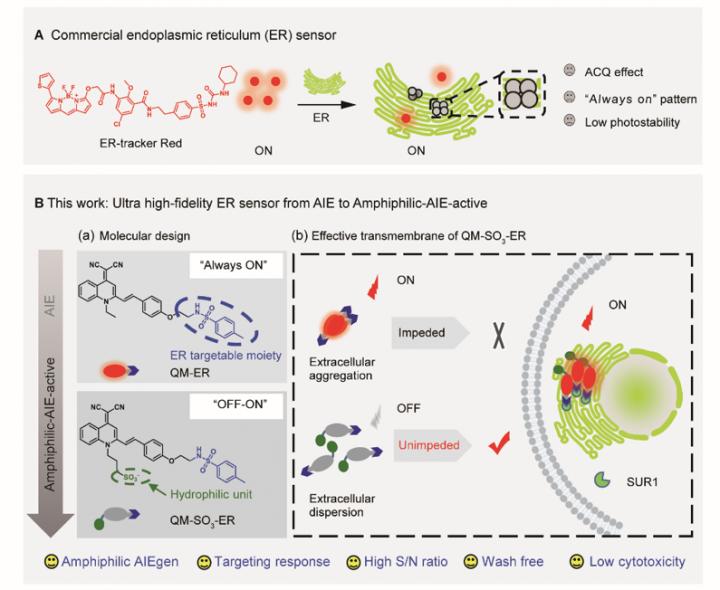
Credit: @Science China Press
Aggregation-induced emission (AIE) sensors bestow distinct advantages on bioimaging, especially in lighting up organelles with targeting events through aggregation process. However, previously reported most AIEgens can only disperse well in either hydrophilic or lipophilic system that always lead to uncontrollable molecular aggregation in the complicated physiological environment. Recently, Wei-Hong Zhu’ group from the East China University of Science and Technology proposed a novel and ideal strategy so-called “amphiphilic AIEgen” to solve the traditional AIE bottleneck, that is, avoiding undesirable aggregations with “fluorescence-off” state during cytomembrane and organelle transport. The specific amphiphilic characteristic could not only prevent aggregation in aqueous biological environment, but also keep good disperse state once entering the lipophilic organelle to avoid false signals, thereby overcoming the bottleneck of AIEgens targetability.
In the unique strategy of this amphiphilic AIEgen sensor, the hydrophilic sulfonate group was utilized to modulate the specific solubility of AIE building block quinoline-malononitrile (QM) in hydrophilic system with desirably initial “fluorescence-off” state. Moreover, the grafted p-toluenesulfonamide group enhanced the dispersity in lipophilic system and behaved as binding receptor to the ATP-sensitive potassium (KATP) on ER membrane. Generally, the unique amphiphilicity could be ascribed to the synergetic contribution: (i) the hydrophilic sulfonate group increases the aqueous solubility, and (ii) the grafted p-toluenesulfonamide group enhances the dispersity in lipophilic system.
The specific amphiphilicity of QM-SO3-ER well settles down the predicament of unexpected “always-on” fluorescence signal and unexpected aggregation signal before binding to ER, and strongly eliminates the background fluorescence caused by uncontrollable polarity change, thereby achieving the high fidelity mapping feedback with overcoming the bottleneck to AIEgens targetability. Specifically, both the cell co-localization experiment and docking study provide evidences on the accurate feedback of in situ mapping ER with extraordinary features, such as beneficial wash-free behavior, ultra-high time-dependent S/N in sensitivity, as well high intrinsic photostability and low cytotoxicity.
The amphiphilic AIE-active sensor with excellent targeting ability can pave a novel and straightforward pathway to build up high-fidelity AIE trapping sensor without false signal from undesirable aggregation before binding to the specific receptor, especially making a breakthrough to overcome the traditional AIE bottleneck to targeting capability, along with high selectivity via the specific receptor interaction.
###
See the article:
Zhirong Zhu, Qi Wang*, Hongze Liao, Ming Liu, Zhengxing Liu, Youheng Zhang and Wei-Hong Zhu*
Trapping endoplasmic reticulum with amphiphilic AIE-active sensor via specific interaction of ATP-sensitive potassium (KATP)
Natl Sci Rev, 2020, doi: 10.1093/nsr/nwaa198
https:/
Media Contact
Wei-Hong Zhu
[email protected]
Original Source
http://doi.
Related Journal Article
http://dx.




